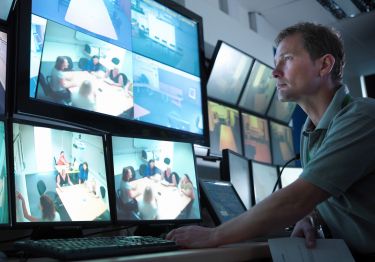I'll be watching you
- Over half of workers (56 per cent) think it’s likely that they’re being monitored at work
- Workplace monitoring is more likely to be happening to younger workers and employees in large companies
- Two-thirds of workers (66 per cent) are concerned that workplace surveillance could be used in a discriminatory way if left unregulated
- 70 per cent think that surveillance is likely to become more common in the future
- Trade unions should have a legal right to be consulted on and to agree in advance the use of electronic monitoring and surveillance at work
- The government should ensure employers can only monitor their staff for legitimate reasons that protect the interests of workers
We’ve recently heard about Amazon patenting wristbands to track warehouse workers, Uber keeping a bit-too-close of an eye on its drivers, and sci-fi sounding software that tracks the emotions and “intensity” of staff.
But these stories only offer a glimpse into the role of surveillance in the workplace. We wanted to know whether they were indicative of wider trends, or just extreme examples.
Our focus on surveillance at work also goes beyond recent news stories. In fact, the trade union movement has been fighting the changing face of workplace surveillance for years. To quote Michael Ford QC when he was writing about workplace monitoring twenty years ago: 1
- 1 Michael Ford (1998), Surveillance and Privacy at Work Institute of Employment Rights
When workplace monitoring is justified and used fairly, it can protect the health and safety of workers and improve business practices. When used badly or inappropriately, however, it becomes symptomatic of an employer’s lack of trust in staff, which in turn demoralises workers and can make staff miserable. Excessive surveillance can also be intrusive and interfere with people’s basic rights to privacy and dignity at work.
We set out to establish the bigger picture so that we have the information needed to best tackle bad practice in workplace monitoring. To do this, we decided to look at:
- How widespread workplace surveillance is
- The impact of surveillance on working people
- How employees feel about being monitored
We found that surveillance is happening now, and it’s happening a lot. Working people also think it’s likely to become more widespread in the future.
A majority of working people (56 per cent) think it’s likely that they’re already being monitored at work. Almost three-in-four (72 per cent) believe it’s at least fairly likely that at least one form of workplace monitoring is happening in their workplace.
The most common forms of surveillance include:
- Monitoring employees’ work emails, files and browsing histories (49 per cent of people think it’s fairly likely or very likely to be happening in their workplace)
- CCTV (45 per cent)
- Phone logs and calls, including the recording of calls (42 per cent)
However, even more advanced forms of surveillance (such as facial recognition and handheld/wearable location tracking devices) are more commonly used than might have been expected.
While workplace monitoring is already an issue for some workers, many people believe that it’s going to become more widespread in the near future. While some people can see some benefits to this, there are clear concerns.
Working people are particularly worried about the impact of surveillance on relationships between workers and their manager, as well as the danger that an increase in unregulated surveillance could lead to a rise in discrimination.
Data protection law, recently strengthened by the General Data Protection Regulation (GDPR), places significant limits on when and how employers should use new technology to monitor their staff in and outside the workplace.
However, too few people know about these rights and how they might apply in their workplace. Many feel unable to challenge employers’ use of surveillance.
Working people are clear about what they want to see happen next, which includes:
- A legal requirement for employers to consult with staff before introducing new forms of surveillance
- Employers to fully justify the use of any new forms of workplace monitoring before they can be enforced
- A clear line between when surveillance is and isn’t acceptable, with an understanding that it isn’t acceptable outside working hours (including while on breaks)
- Regulations to be put in place to stop monitoring being used in a discriminatory way
In the report, we’re going to go into more detail on the issues covered in this executive summary. There’s four sections, covering:
- What workplace surveillance is
- Where it’s happening, how much it’s happening and who’s most affected by it
- How workers feel about surveillance
- What changes workers would like to see and what new policies are required to bring about that change
Methodology
The TUC commissioned BritainThinks to carry out qualitative and quantitative research into workplace surveillance.
The qualitative stage of research involved a range of focus groups and depth interviews held across four cities: London, Birmingham, Manchester and Bristol.
The results of these groups and interviews were used to create a quantitative survey. BritainThinks then carried out a nationally representative online survey between 18th and 21st May 2018 that received 2,100 responses from members of the UK public. The results were weighted to be representative of the adult UK population.
Questions relating to an individuals’ specific workplace or current experiences of work were only asked to those currently in work (base size, 1,099, weighted to 1,210). The figures included in this report are based on the answers given by those in work.
Stay Updated
Want to hear about our latest news and blogs?
Sign up now to get it straight to your inbox


